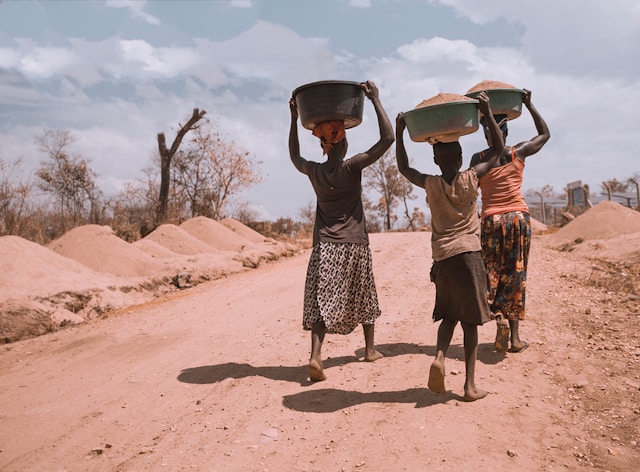Introduction
Climate Change is the defining crisis of our time, threatening people’s lives by rising sea levels and extreme weather conditions. Its impacts primarily affect marginalized groups, but women are more vulnerable than men to climate induced risks. Since climate change affects gender equality and gender justice, it is necessary to mitigate its severe impacts on women. Legislative and institutional reforms must be undertaken to promote gender equality in the climate justice discourse in the Global South, which will be examined in the following.
Climate Justice
Climate impacts are not distributed equally and often have disproportionate consequences for marginalized communities, especially for people in the Global South. Climate justice is a movement that acknowledges the varied social, economic, public health, and other impacts of climate change on underprivileged communities. It follows the principle of “common but differentiated responsibilities.” The goal is to find solutions to the climate crisis to create a fairer and more equitable world. Industrialized nations have emitted more greenhouse gases than developing nations, placing a greater responsibility on wealthy nations to act against climate change.[1].
Gender Justice
Currently, the dominant discourse of climate change is heavily masculine, and gender equality is not a central topic. Gender equality emphasizes that women and men regardless of their class and race, should have equal access to resources, freedoms and opportunities[2]. Neglecting this is highly problematic, as women as women are more vulnerable to climate-induced risks due to their gender roles.
Climate does not occur in a vacuum but rather in the context of other challenges such as women’s well-being, social status, globalization and conflict. Due to historic structures, the cultural traditions and established gender roles, women often serve as caregivers, providers and resource collectors[3]. They have much to lose – not only their livelihoods. They are also responsible for the survival and health of their children.
Furthermore, women face heightened risks due to deeply ingrained social norms[4]. In many communities, they are responsible for providing water and fuelwood for heating and cooking[5]. However, as water shortages and deforestation increase, these tasks require more time and effort. Women must walk longer distances to collect water, exposing them to a greater risk of sexual assault, which further exacerbates their vulnerability to climate-induced risks.
Women are 14 times more likely than men to die during natural disasters[6]. This is due to factors such as poorer health, inadequate nutrition, unsafe living and working conditions, as well as social constraints, including social stigma, restrictive clothing, and lack of survival skills. These issues contribute to higher female mortality rates, particularly during hurricanes and floods[7].
Climate justice is gender justice. Ensuring that climate change strategies and policies incorporate gender perspectives will lead to a more equitable society where existing inequalities are less pronounced.
Reforms
Which reforms have been implemented to promote gender equality in the climate justice discourse in the Global South? The following section critically examines two amendments to assess their effectiveness.
Maputo Protocol
The Protocol to the African Charter on Human and Peoples’ Rights on the Rights of Women in Africa (Maputo Protocol) is a legally binding multilateral supplement, recognized as “one of the world’s most comprehensive and progressive human rights instruments”[8]. t came into effect in 2005 and significantly improved African women’s rights, particularly in relation to harmful traditional practices, health, political participation, and economic empowerment. A special focus is placed on Article 19, which guarantees women the right to fully enjoy sustainable development. It emphasizes a gender perspective in national development planning, ensuring greater participation of women at all levels, particularly in decision-making, implementation, and evaluation of development policies and programs. Since 2005, 49 African Union member states have signed the protocol, and 37 have ratified it. However, critics argue that the protocol does not systematically engage with each of the Charter’s rights. Some rights receive less attention—for instance, women’s right to property has been subsumed under broader rights within Article 19.
The Maputo Protocol is part of a rapidly evolving landscape in which women’s rights are taken more seriously than in the past. While it has the potential to advance gender equality, its actual impact depends on the level of awareness and understanding of its content, as well as its effective integration into policies.[9].
Gender Action Plan
At the 25th Conference of the Parties (COP25) in 2019, the parties agreed on the Gender Action Plan (GAP), which includes the Lima Work Programme on Gender (LWPG). This initiative was established to incorporate gender considerations into climate justice discourse, such as those outlined in the Paris Agreement[10]. This development is positive, as it increases the visibility of gender issues. At COP29, held in November 2024, the parties concluded a final review and decided to extend the LWPG for an additional 10 years. They also resolved to develop a new GAP, with the process set to begin in June 2025. The important work of the GAP was acknowledged, and “the ongoing need for gender mainstreaming through all relevant targets and goals in activities under the Convention”[11] was recognized. While some positive outcomes and developments related to the GAP were noted, negative developments were also observed, particularly the growing climate change impacts on local communities and Indigenous Peoples. In conclusion, there is a lack of progress. Parties have failed to truly prioritize the GAP, and a genuine gender-responsive implementation is missing. Discussions are prolonged, and the most recent reports that could affect change are not addressed[12]. The lesson is clear: Parties have the ability to effect change and recognize gender in climate justice discourse, but implementation is lacking. There is too much talk and too little action.
The Way Forward
The reforms create the impression of progress toward gender equality in the climate justice discourse in developing countries, but significant problems and gender gaps remain. There is a lack of clear strategies to achieve gender-related goals. Policymakers and governments often shift responsibilities to NGOs, which results in little to no improvement in the current situation.
A disconnect exists between various strategies and policies, as there are no unified gender plans or inclusive approaches. Clear guidelines on how to integrate gender into climate change policies are missing. Implementation plans and strategies must be revised to ensure gender inclusion. Current policies remain far from being gender-transformative and lack the potential to meaningfully address existing gender gaps in the climate justice discourse[13]. While the reforms mark a step in the right direction by promoting at least a gender-sensitive approach, objectives cannot be achieved without clear guidelines. Gender justice is essential to reducing women’s heightened vulnerability to climate-induced risks. True justice can only be achieved when it is equally shared by all, making gender justice a priority for everyone.
[1] McKinney, Laura A., Fulkerson, Gregory M., ‘Gender Equality and Climate Justice: A Cross-National Analysis’ (2015) Soc Just Res 28:293-317 <https://www.researchgate.net/publication/277605104_Gender_Equality_and_Climate_Justice_A_Cross-National_Analysis> S. 294, accessed on 30 January 2025
[2] UNFPA, „Gender Equality“<https://esaro.unfpa.org/en/topics/gender-equality#:~:text=Gender%20equality%20is%2C%20first%20and,and%20opportunities%20to%20exercise%20control.> accessed 12 February 2025
[3] Terry, Geraldine, ‘No Climate Justice without Gender Justice: An Overview of the Issues.’ (2009) Gender and Development, Vol. 17, No. 1, 5-18 <http://www.jstor.org/stable/27809203> accessed 30 January 2025
[4] Africa Development Bank, ‘Climate Change, Gender and Development in Africa’ (2011) <https://www.afdb.org/sites/default/files/documents/publications/climate_change_gendge_and_development_in_africa.pdf>, S. 1, accessed on 30 January 2025; Lahiri-Dutt, Kuntala, ‘Climate Justice Must Integrate Gender Equality: What are the Key Principles?’ (2012) Impact of Climate Change on Water and Health, 106-109
[5] Figueiredo, Patricia, Perkins, Patricia E., ‘Women and water management in times of climate change: participatory and inclusive processes’, Journal of Cleaner Production, Vol. 60 (2013), pp. 188-194; Africa Development Bank, ‘Climate Change, Gender and Development in Africa’ (2011) < https://www.afdb.org/sites/default/files/documents/publications/climate_change_gendge_and_development_in_africa.pdf>, S. 1, accessed on 30 January 2025; Africa Development Bank, ‘Information Note on the Checklist for Mainstreaming Gender and Climate Change in Projects’ (2009d), <https://www.afdb.org/en/documents/document/information-note-on-the-checklist-for-mainstreaming-gender-and-climate-change-in-projects-20016> accessed 30 January 2025
[6] UN Women, <https://unwomen.de/klima-und-gender/> accessed 30 January 2025
[7] Africa Development Bank, ‘Climate Change, Gender and Development in Africa’ (2011) <https://www.afdb.org/sites/default/files/documents/publications/climate_change_gendge_and_development_in_africa.pdf>, S. 1, accessed on 30 January 2025; Africa Development Bank, ‘Information Note on the Checklist for Mainstreaming Gender and Climate Change in Projects’ (2009d), <https://www.afdb.org/en/documents/document/information-note-on-the-checklist-for-mainstreaming-gender-and-climate-change-in-projects-20016> accessed 30 January 2025
[8] Viljoen, Frans, ‘An Introduction to the Protocol to the African Charter on Human and Peoples’ Rights on the Rights of Women in Africa’ (2009) Washington and Lee Journal of Civil Rights and Social Justice, 16(1), 11-46; Protocol to the African Charter on Human and Peoples’ Rights on the Rights of Women in Africa (Maputo Protocol) 2005
[9] Viljoen, Frans, ‘An Introduction to the Protocol to the African Charter on Human and Peoples’ Rights on the Rights of Women in Africa’ (2009) Washington and Lee Journal of Civil Rights and Social Justice, 16(1), 11-46
[10] UNFCCC, ‘The Gender Action Plan ‘<https://unfccc.int/topics/gender/workstreams/the-gender-action-plan> accessed 12 February 2025; UNFCCC ‘Lima Work Programme On Gender (LWPG)’, <https://www4.unfccc.int/sites/NWPStaging/Pages/Lima-Work-Programme-on-Gender.aspx> accessed 4 February 2025
[11]UNFCCC, <https://unfccc.int/sites/default/files/resource/COP29_auv_agenda_item_14_gender.pdf> accessed 30 January 2025
[12] Women and Gender Constituency, ‘No Gender Justice in the Gender Action Plan’, <https://womengenderclimate.org/no-gender-justice-in-the-gender-action-plan-gap/> accessed 30 January 2025
[13] Acosta, Mariola, Ampaire, Edidah, Okolo, Wendy, Twyman, Jennifer, Jassogne, Laurence, ‘Info Note: Climate Change Adaptation in Agriculture and Natural Resource Management in Tanzania: A Gender Policy Review’ (2016) <https://cgspace.cgiar.org/handle/10568/77770> accessed on 30 January 2025

